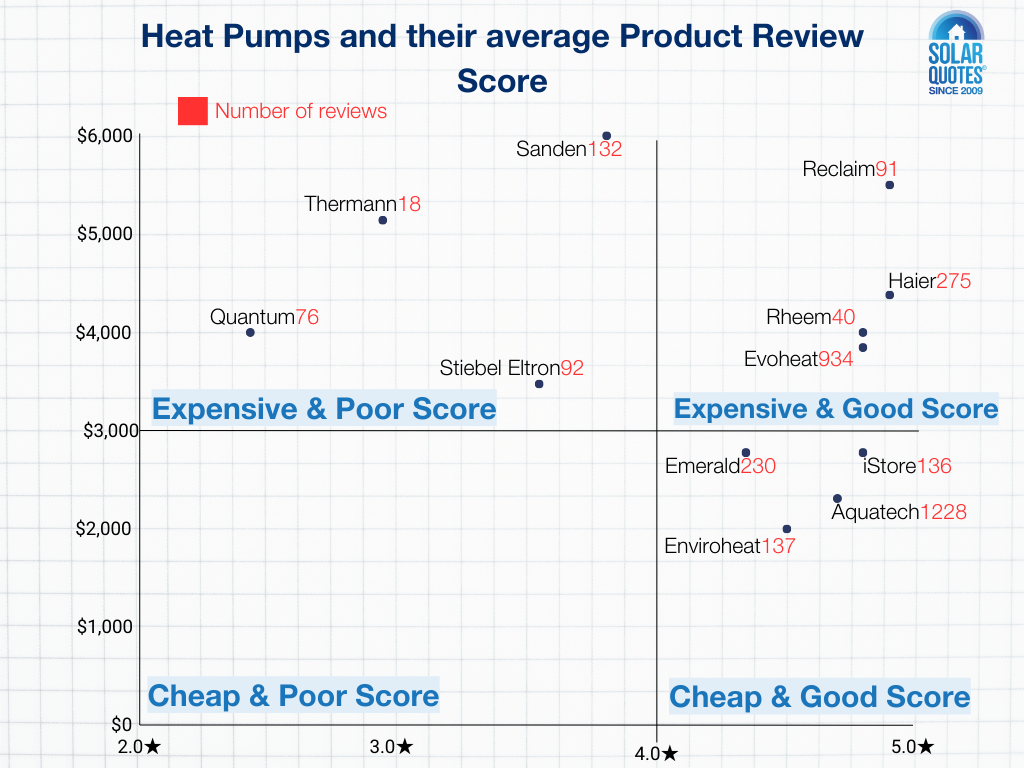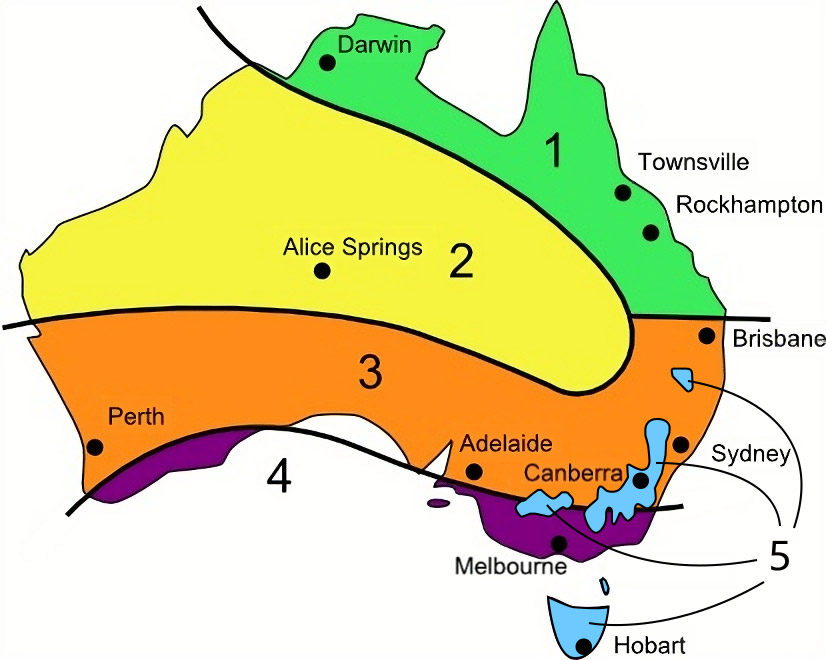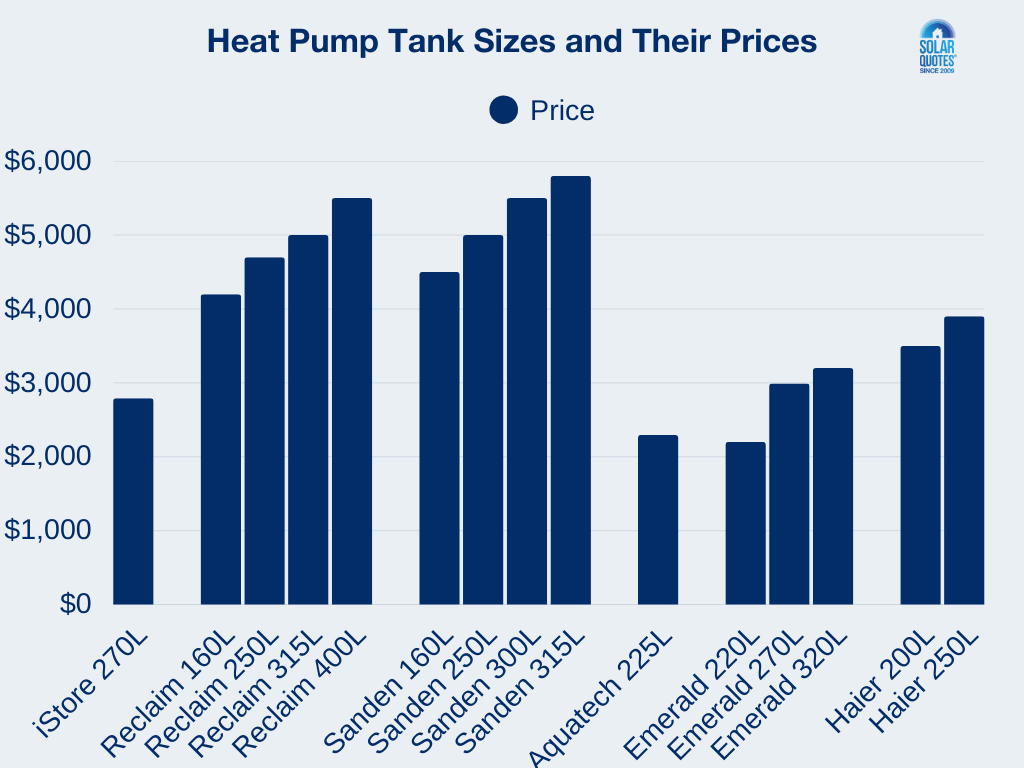Heat Pump Hot Water: Choosing the Right System
Last Updated: 19th Dec 2025 By Finn Peacock, Chartered Electrical Engineer
Hot water heat pumps are the most efficient way to heat water. This article explains how they work, and how to buy a good one. I’ll break down the costs, highlight the best models in Australia, and explain how you can take advantage of government rebates. Plus, I’ll cover efficiency, cold weather, noise levels, and installation.
Heat Pump Comparison Table
Compare heat pump prices and specifications side-by-side.
| Product Name | Apricus |
Aquatech X6
|
Ecogenica R-series split | Emerald All-In-One | Enviroheat | Evoheat-1 | Haier Monoblock | iStore | Quantum | Reclaim | Rheem Ambiheat | Rinnai Enviroflo | Sanden | Solahart Atmos Eco | Stiebel Eltron WWK | Thermann Split |
|---|---|---|---|---|---|---|---|---|---|---|---|---|---|---|---|---|
| Manufacturer Logo |
 |
 |
 |
 |
 |
 |
 |
 |
 |
 |
 |
 |
 |
 |
 |
 |
| Product Image |
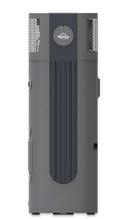 |
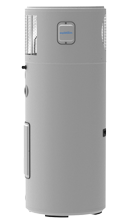 |
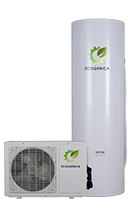 |
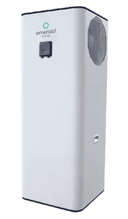 |
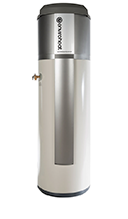 |
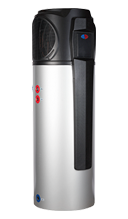 |
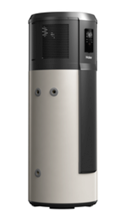 |
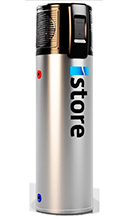 |
 |
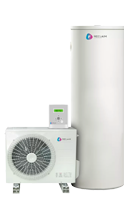 |
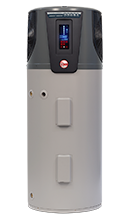 |
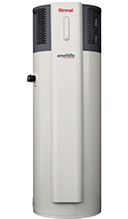 |
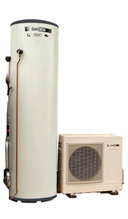 |
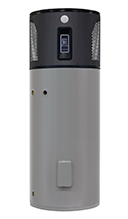 |
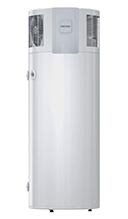 |
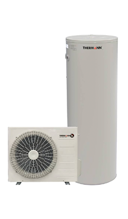 |
| Choose model: | ||||||||||||||||
| Approx price (RRP + GST, excl. installation) | $3,500 | $2,295 | $2,200 | $2,990 | $2,000 | $3,800 | $3,900 | $2790 | $3500 | $5000 | $3,629 | $3,850 | $5800 | $3,500 | $3,500 | $5,223 |
| Tank size | 260L | 225L | 215L | 270L | 250L | 270L | 250L | 270L | 270L | 315L | 270L | 315L | 315L | 280L | 302L | 315L |
| Tank dimensions (mm) | 1800 x 620 | 1580 x 620 | 1815 x 510 | 1826 x 600 | 1965 x 629 | 1992 x 640 | 1951 x 630 | 1950 x 640 | 1900 x 650 | 1765 x 617 | 1825 x 690 | 2134 x 627 | 1748 x 719 | 1832 x 690 | 1921 x 690 | 1762 x 624 |
| Refrigerant | R290 (Propane) | R290 (propane) | R290 (propane) | R290 (propane) | R134a | R134a | R290 | R290 (propane) | R290 (Propane) | R744 (CO2) | R513a | R290 (propane) | R744 (CO2) | R290 (Propane) | R134a | R744 (CO2) |
| Warranty | 6 years | 5 years | 7 years tank, 5 years heat pump | 5 years | 5 years tank, 1 year electronics | 6 years tank, 5 years compressor and parts | 7 year tank, 5 year parts and labour | 5 years | 5 years tank, 2 years electrics | 10 years (wi-fi enabled) | 7 years tank, 3 years sealed system | 7 years tank, 3 years heat pump, 1 year valves | 10 years tank, 6 years heat pump | 7 years tank, 3 years pump, 1 year electronics | Cylinder 5 years, valves 1 year | 6 years heat pump, 10 years tank, 2 years parts |
| Additional resistive element? | Yes | Yes | No | No | No | Yes | Yes | Yes | No | No | Yes | Yes | No | Yes | No | No |
| Time to reheat full tank | 5.2 hours | 3.2 hours | 3.2 hours | 3.5 hours | 5 hours | 3 hours | 3.5 - 5 hours | 4.15 hours | 3.71 hours | 3.08 hours | 3.5 hours | 4 hours | 3.61 hours | 4.5 hours | 5 hours | Not specified |
| Operating temperature range | -7 - 43°C | -5 to 43°C | -7 to + 43°C | -7 to 43°C | -7 to 46°C | -7 to 43°C | -7 to 45°C | -7 to 45°C | -10 to 35°C | -10 to 43°C | -5 to 43°C | -1 to 45°C | -10 to 43°C | -6 to 43°C | -5 to 42°C | -10 to 43°C |
| Coefficient of performance (COP) | 4.13 | 4.15 | 5 | 4.9 | 3.9 | 4.27 | 4.49 | 4.8 | 4.3 | 5 | 4.5 | 5 | 5 | 5.2 | 3.94 | 5 |
| Does it have a simple, midrange or smart timer? | (Smart) | (Simple) | (No) | (Smart) | (Simple) | (Smart) | (Midrange) | (Midrange) | (No) | (Smart) | (Midrange) | (Simple) | (Smart) | (Simple) | (No) | (Simple) |
| Typical power draw | 0.7kW | 0.9kW | 0.65kW | 0.6kW | 0.5kW | 0.94kW | 0.43kW | 0.94kW | 0.87kW | 0.85kW | 0.7kW | 0.94kW | 0.87kW | 0.69kW | 0.64kW | 0.95kW |
| Max power draw | 2.8kW | 1.8kW | 1kW | 0.6kW | 0.8kW | 1.5kW | 2.25kW | 1.5kW | 0.87kW | 2.5kW | 2.4kW | 2.4kW | 2.3kW | 2.4kW | 0.64kW | 2.5kW |
| Max decibels | 43dB | 42dB | 50dB | 49dB | 46dB | 48dB | 43dB | 46dB | 50dB | 37dB | 48dB | 48dB | 37dB | 45dB | 45dB | 37dB |
| Country of manufacture | China | China | China | China | China | China | China | China | China | Heat pump - Japan. Tank - Australia. | Australia | Australia | Heat pump - Japan. Tank - Australia | TBD | Slovakia | Tank - Australia. Compressor - Japan. |
| STCs (Zone 3) | 21 | 21 | 23 | 21 | 21 | 21 | 21 | 21 | 20 | 21 | 21 | 21 | 21 | 21 | 20 | 22 |
| Datasheet Supplied? | Apricus datasheet | Aquatech X6 datasheet | Ecogenica R-series datasheet (split) | Emerald all-in-one datasheet | Enviroheat datasheet | Evoheat datasheet | Haier Monoblock datasheet | iStore heatpump datasheet | Quantum datasheet | Reclaim datasheet | Rheem Ambiheat datasheet | Rinnai Enviroflo datasheet | Sanden datasheet | Solahart Atmos datasheet | Stiebel Eltron WWK datasheet | Thermann split datasheet |
| Warranty Supplied? | Apricut warranty | Aquatech X6 warranty | Ecogenica R-series warranty | Emerald all-in-one warranty | Enviroheat warranty | Evoheat warranty | Haier Monoblock warranty | iStore heatpump warranty | Quantum warranty | Reclaim warranty | Rheem Ambiheat warranty | Rinnai Enviroflo warranty | Sanden warranty | Solahart Atmos warranty | Stiebel Eltron WWK warranty | Thermann split warranty |
| More information on brand | Here | Here | Here | Here | Here | Here | Here | Here | Here | Here | Here | Here | Here | Here | Here | Here |
Table of Contents
- What Is A Heat Pump Hot Water System?
- Heat Pump Comparison Table
- How Much Does a Hot Water Heat Pump Cost?
- What Are the Best Hot Water Heat Pumps in Australia?
- Our Recommended Hot Water Heat Pump Chart
- Heat Pump Hot Water Rebates
- How Efficient is a Hot Water Heat Pump?
- What to Look for in a Good Hot Water Heat Pump
- How Does A Hot Water Heat Pump Work?
- Heat Pump vs. Conventional Resistive Hot Water: How Do They Compare?
- Heat Pump vs. Solar Thermal Hot Water: How Do They Compare?
- Heat Pump Water Heater Installation
- Plumbing Considerations
- Heat Pump Hot Water and Water Quality
- Integrating Heat Pump Hot Water with Your Solar Panels
- Integrating Heat Pump Hot Water with Your Home Battery
- FAQs
- Conclusion
What Is A Heat Pump Hot Water System?
Hot water heat pumps (often abbreviated to ‘heat pumps’ here in Australia) use the same principles as reverse-cycle air conditioners to heat water. They transfer heat from the outside air to a hot water tank. Because it’s transferred rather than created, they are the most energy-efficient way to heat water with electricity.
How Much Does a Hot Water Heat Pump Cost?
An installed heat pump hot water system starts at about $3,000 for a good budget unit, such as iStore. It goes up to around $7,000 for a more efficient, faster heating premium model, such as Reclaim. This assumes a simple installation using existing electrical connections and no structural work to mount the tank. The price may be less if your state or territory provides a heat pump rebate.
Beware of cheap junk!
You can get a hot water heat pump for under $2,000, but in my experience, you’ll likely end up with something noisy, inefficient and unreliable. Cheap, nasty units have given heat pumps a bad name with Australian plumbers. But I’m here to tell you that good heat pumps are quiet, efficient and long-lasting.
What Are The Best Hot Water Heat Pumps in Australia
By looking at online reviews for hot water heat pumps in Australia, we can see which are the best according to consumers. Those without at least 15 reviews on productreview.com at the time of writing were excluded.
The top-rated heat pump is Haier with an average score of 4.9 stars.
Reclaim heat pumps are second: also 4.9 stars but a lot less reviews than Haier. With their CO2 refrigerant, high efficiency, and near-silent running, they have a good reputation in the industry. I installed one on my home three years ago, and it’s going great. They are pricey, though, at $6,000-$7,000+ installed. I got mine before Reclaim partnered with Panasonic. But if you get one nowadays, the compressor unit will be a Panasonic.
iStore has also proven itself as a great budget option with 4.8 stars on 136 reviews.
Quantum, Thermann, Sanden and Stiebel Eltron all have relatively poor average scores at time of writing.
We asked installers in our network which brand they would install on their house in 2025. iStore took gold, Solahart won silver, and Reclaim came away with bronze.
Our Recommended Hot Water Heat Pump Chart
I’ve put the brands I trust and would recommend to a friend in our Recommended Heat Pump Chart:
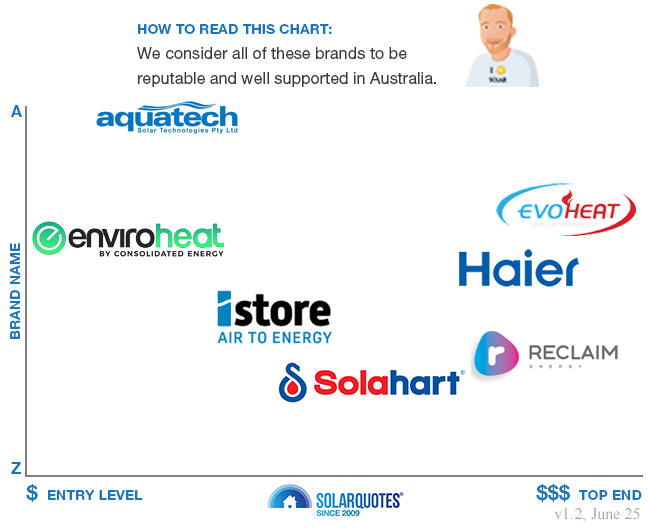
Heat Pump Hot Water Rebates
Australia-wide rebates: STCs
Not a lot of people realise that – similar to the national ‘solar rebate’ – there is also a national ‘hot water heat pump rebate’ which can reduce the upfront cost of your heat pump by about $650.
The government gets really pissed when it’s called a rebate and prefers the discount to be called ‘claiming STCs’ (Small-scale Technology Certificates).
All you need to know is that all good heat pumps with a tank under 425 litres can claim STCs to get the discount, and the amount varies based on how much energy they will save typical households. While a warm climate makes heat pumps more efficient, it also reduces hot water use, so slightly less STCs are received in warmer zones.
These climate zones rank from 1 through 5:
The STC discount is almost always included in the advertised price of the fully installed heat pump.
Hot Water Heat Pump STC Calculator
If you want to know how many STCs you can expect for the heat pump you are considering, check out our new Hot Water Heat Pump STC Calculator.
Hot Water Heat Pump State/Territory Rebates & Incentives
| Victoria | Most Victorian households are eligible for a rebate of up to $1,000 for upgrading an electric or gas hot water system to a heat pump. If selecting a locally made heat pump, you can get up to a $1,400 rebate. There’s also an additional rebate available to homes and businesses of around $600. |
| New South Wales | The New South Wales Government provides a discount on the installation of a hot water system with a minimum warranty of 5 years. If you’re eligible, incentives are available up to: – $640 when you replace an electric water heater with an air source heat pump water heater – $330 when you replace a gas water heater with an air source heat pump water heater. If you live in the Randwick local government area, you can receive rebates of 25% the cost of a heat pump hot water system, up to a maximum of $500. |
| South Australia | The Retailer Energy Productivity Scheme (REPS) provides a financial incentive for heat pump hot water systems. For households without gas the incentive can be around $930 while for those with gas connections it’s around $270. If you’re a pensioner, Health Care Card holder, or otherwise a member of a REPS Priority Group, it increases by around $124. The incentive goes to installers and they decide how it’s passed on to customers. The City of Adelaide offers its residents 50% off up to $2000 for replacing gas or wood-burning appliances with an electric or solar-powered appliance. This includes replacing a gas hot water system with heat pump hot water. |
| Queensland | Currently no state-level rebates for heat pumps in Queensland. |
| Western Australia | Currently no state-level rebates for heat pumps in WA. |
| Northern Territory | Currently no state-level rebates for heat pumps in the NT. |
| Australian Capital Territory |
If you are with ActewAGL and you are upgrading a gas or electric hot water system, you can get $1,250 off the purchase price of your new heat pump as well as a $250 credited to your electricity bills over the next three years – that’s $20.84 per quarter. Eligible homeowners in the ACT can also use the Sustainable Household Scheme to get a 3% interest home electrification loan for up to $15,000 that could be spent on heat pumps. |
| Tasmania | Currently no state-level rebates for heat pumps in TAS. |
How Efficient is a Hot Water Heat Pump?
In Australia, a decent quality heat pump hot water system is typically at least three times more efficient than regular electric hot water.
Here’s how it does it:
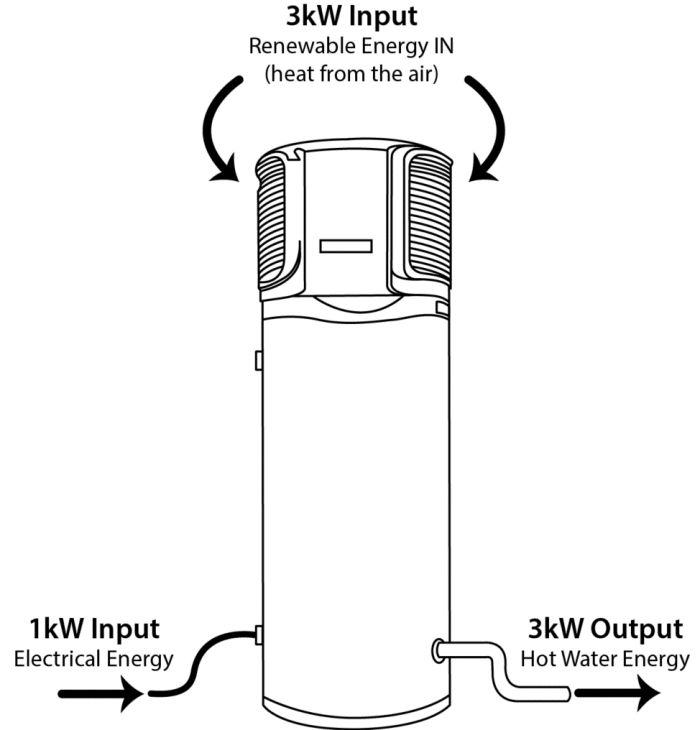
In the picture above, the heat pump is operating at 300% efficiency. If that sounds like magic pudding, it’s because we measure a heat pump’s efficiency relative to a simple resistive hot water heater that creates heat and converts almost 100% of the electrical energy into heat, whereas a heat pump can provide 3 or more times the heat for the same electrical energy.
Pro-Tip: The efficiency depends on the outside air temperature. When the air is below freezing, the efficiency will move closer to 100%, and when it is warm outside, it can go over 600%. A good hot water heat pump’s efficiency will vary from about 150% when -10ºC outside to around 500% when 25ºC outside.
What to Look for in a Good Hot Water Heat Pump
Efficiency (STCs)
All else being equal, the more efficient the heat pump, the cheaper it will be to run. The best way to get an idea of its electricity running costs is to look at how many STCs it provides in your area. The more STCs, the more energy it’s likely to save a typical household. However, the difference between brands is minimal.
Speed of heating (Litres per hour)
A heat pump isn’t much use if it takes too long to heat the water. You don’t want to wait ages for more hot water after the family’s morning showers, and if you have solar panels, you want the water heated during peak sunlight hours to use solar instead of the grid.
The light-blue bars in the chart below show each manufacturer’s own recovery rate figure. The dark-blue bars show SolarQuotes’ average noon-estimates based on consistent conditions (20°C air, 15°C inlet water, 45°C temperature rise, 60% relative humidity).
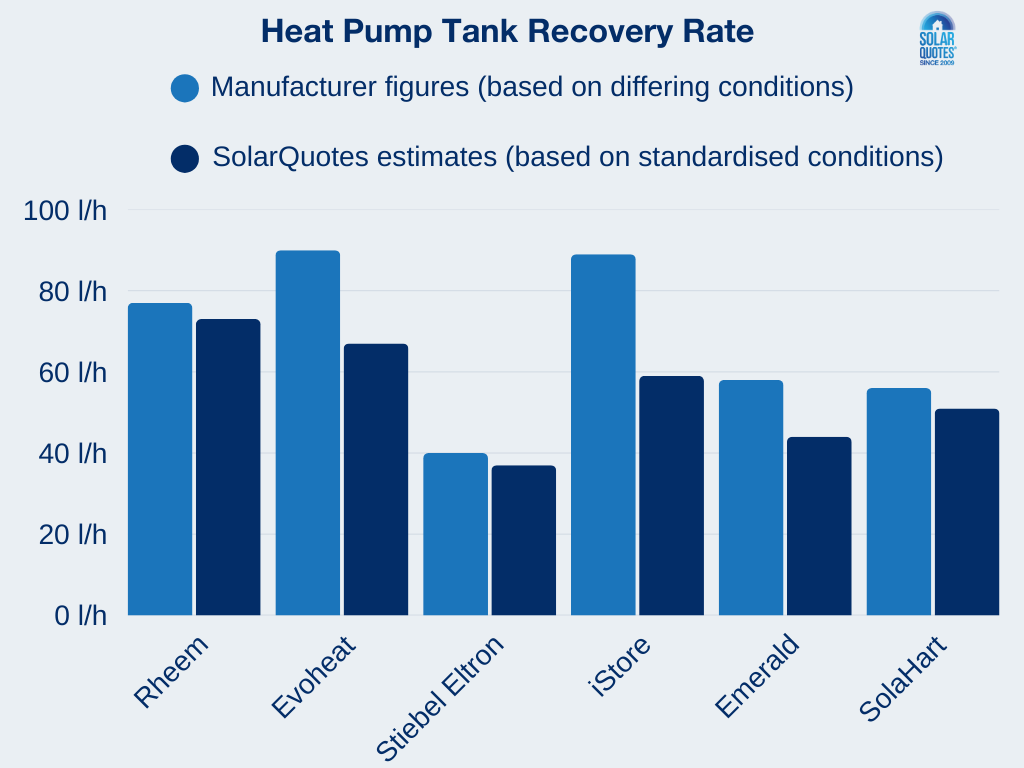
Manufacturers use different test temperatures and sometimes include electric-booster heating, so their numbers aren’t directly comparable. Our estimates aim to put all brands on the same footing and give you a more realistic idea of how quickly each unit can re-heat a full tank on a cool day.
Remember, hot water rises to the top of the tank, so you rarely need the entire tank to be at full temperature before you can shower.
Capacity (litres)
Most people buy a heat pump with a 270-350 litre hot water tank as that’s a good size for a typical 4-5 person family. If you are a 1-2 person home and not planning on expanding 150 litres should work well. If you’ve got 6 people or more, don’t get anything smaller than 315 litres. The biggest residential heat pumps have a 400-litre tank.
Type (Split vs. All-in-one)
A Split HWHP (e.g Sanden, Reclaim brands) has the cylindrical water tank separate from the compressor/heat exchanger unit. Advantages are:
- Slightly better efficiency,
- Slightly faster heating rate,
- Slightly quieter,
- Longer lasting sacrificial anode1.

An all-in-one HWHP such as the iStore or Evoheat is a big cylinder with the heat exchanger on top. Its advantages:
- a smaller footprint,
- less external pipework,
- easier to install,
- cheaper than split systems.

Warranty
Often, the tank and compressor/heat exchanger have different warranties. Don’t accept less than 5 years for the compressor/heat exchanger or less than 10 years for the tank. The best warranty I know of is Reclaim, which offers up to 10 years on the compressor unit and up to 15 on the tank.
Noise
Good heat pumps are quiet, ranging from 37 decibels (an overhead fan at low speed) to 50 decibels (a louder than average fridge). If they operate during the day to take advantage of rooftop solar power noise normally isn’t an issue. Split systems are usually quieter than all-in-ones.
Refrigerant
The refrigerant is the fluid that transfers the heat from the air to your hot water. Three main refrigerants are used by HWHPs sold in Australia: R134A, Propane and CO2, used in cheap, mid-range and expensive heat pumps respectively. This table shows their pros and cons:
| Refrigerant | English name | Pros | Cons | Used By |
|---|---|---|---|---|
| R134A | HFC (hydrofluorocarbon) | Allows for cheaper heat pump due to lower pressures. | Being slowly phased out in Australia due to horrible Global Warming Potential (~1430x worse than CO2). | Thermann all-in-one, Midea, Rheem, Evoheat, and all really cheap HWHPs |
| R290 | Propane | Low global warming potential | Highly Flammable | Aquatech, EcoGenica, iStore, Qantum, Haier, Rinnai |
| R744 | Carbon Dioxide (CO2) | Efficient and small quantities used make it environmentally friendly | Used at higher pressure, so needs better engineered heat pump, thus more expensive. | Reclaim, Sanden, Thermann split systems. |
STCs
Heat pumps receive a number of STCs based on how much energy they’ll save a typical Aussie home in a climate zone. They provide a consistent way to compare different models based on energy savings.
Unlike manufacturer claims, which can vary based on conditions such as air temperature, STCs are based on standardised testing and modelling. They take into account how climate affects heat pump efficiency and hot water consumption.
So while heat pumps work more efficiently in tropical Townsville than chilly Hobart, because little hot water is used in the tropics, they receive more STCs in Hobart because they will save more energy in total.
This makes STCs a more reliable indicator of how a heat pump will perform in real-world conditions, helping you make better choices when selecting a model. We’ve put the STC value for each heat pump in the comparison table above.
STCs are used by the government to provide a point-of-sale discount on the cost of heat pumps. The more STC’s the bigger the rebate, because the better the expected energy (and CO2) savings. The STC discount is almost always included in the prices you see advertised.
How Does A Hot Water Heat Pump Work
A domestic electric heat pump hot water system is similar to a reverse cycle air conditioner. But instead of moving heat energy from outside air into your home, it’s moved into a water storage tank.
Here’s a simple explanation of how it works:
- Inside the heat pump, there’s refrigerant: a special fluid that boils at a low temperature.
- The heat pump compresses refrigerant gas. This makes it hot so it heats water in the storage tank.
- Because heat is transferred to the water, the refrigerant cools and mostly condenses into liquid.
- The refrigerant is then sent to the evaporator coil and the pressure is reduced as it enters. This causes the refrigerant liquid to expand into gas, and as it expands, it gets colder.
- The evaporator coil is piping with a fan blowing outside air around it. Because the refrigerant is colder than the air, it absorbs heat from it.
- The now warmer refrigerant gas is then compressed and becomes hot and the cycle continues.
In this way, the heat pump uses a small amount of electrical energy to transfer a much larger amount of heat energy from outside air to stored water.
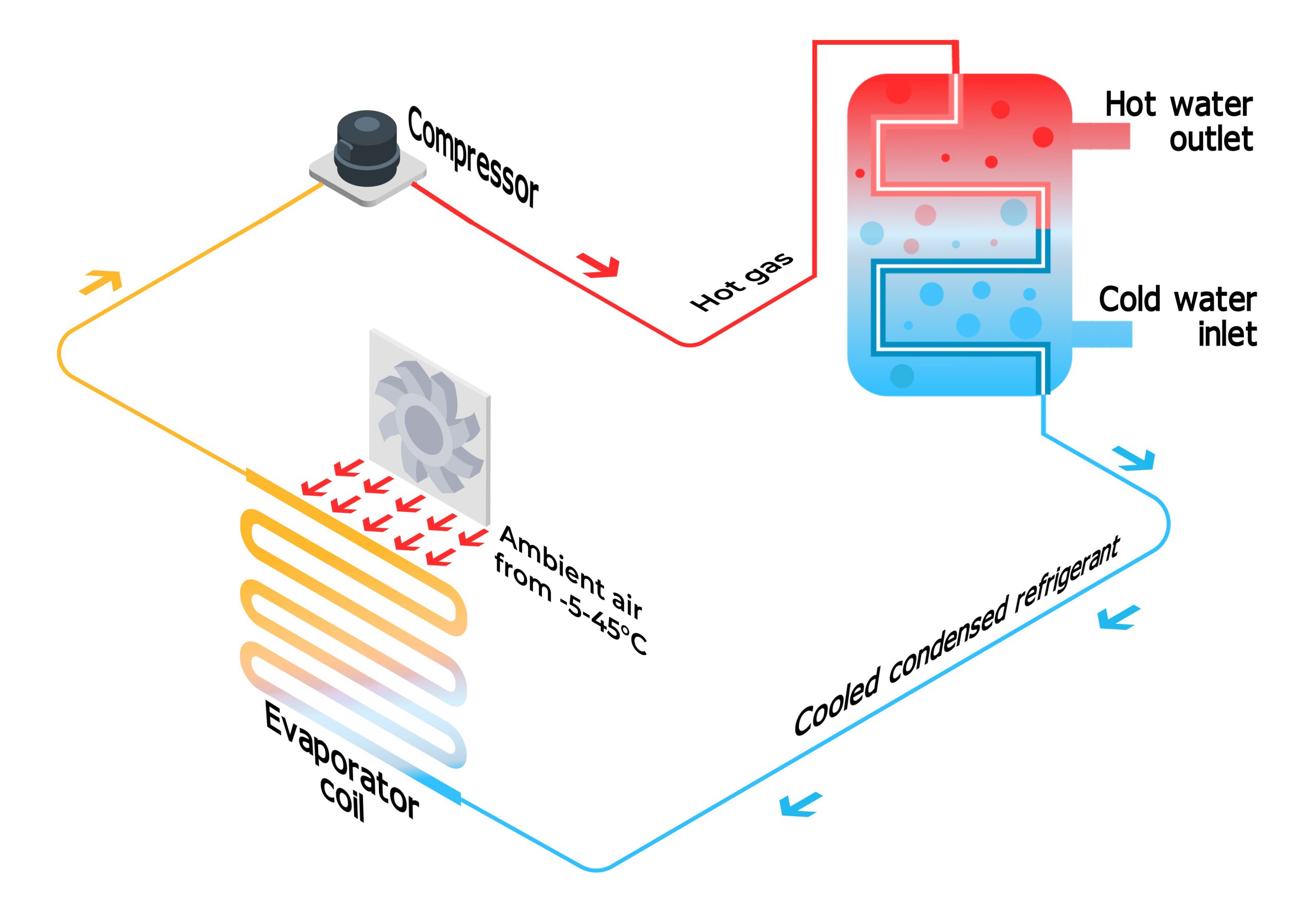
The components of a heat pump hot water system making all this magic happen are:
a) Evaporator Coil
This is where the heat pump absorbs heat from the outside air. Refrigerant enters the coil at low pressure and low temperature and absorbs heat energy.
b) Compressor
The compressor increases the pressure of refrigerant gas, raising its temperature. This step is crucial for transferring heat to the tank’s water.
c) Condenser Coil
In the condenser coil, the hot refrigerant gas releases heat to the water in the storage tank. As the refrigerant cools it mostly condenses into liquid.
d) Expansion Valve
This component controls the flow of the refrigerant into the evaporator coil. It reduces the pressure of the mostly liquid refrigerant, causing it to expand into gas and cool further, ready to absorb more heat from the outside air.
e) Water Storage Tank
This is where the heated water is stored until it is needed. The tank is insulated to minimise heat loss.
f) Fan
The fan helps move air over the evaporator coil, improving the heat exchange process by increasing its transfer rate.
g) Refrigerant
This is the working fluid that circulates through the system. It releases heat as it condenses from gas into a liquid and absorbs heat when it vaporises from a liquid into a gas.
h) Control System
This system includes thermostats and other controls that regulate the heat pump’s operation, ensuring efficient and safe operation.
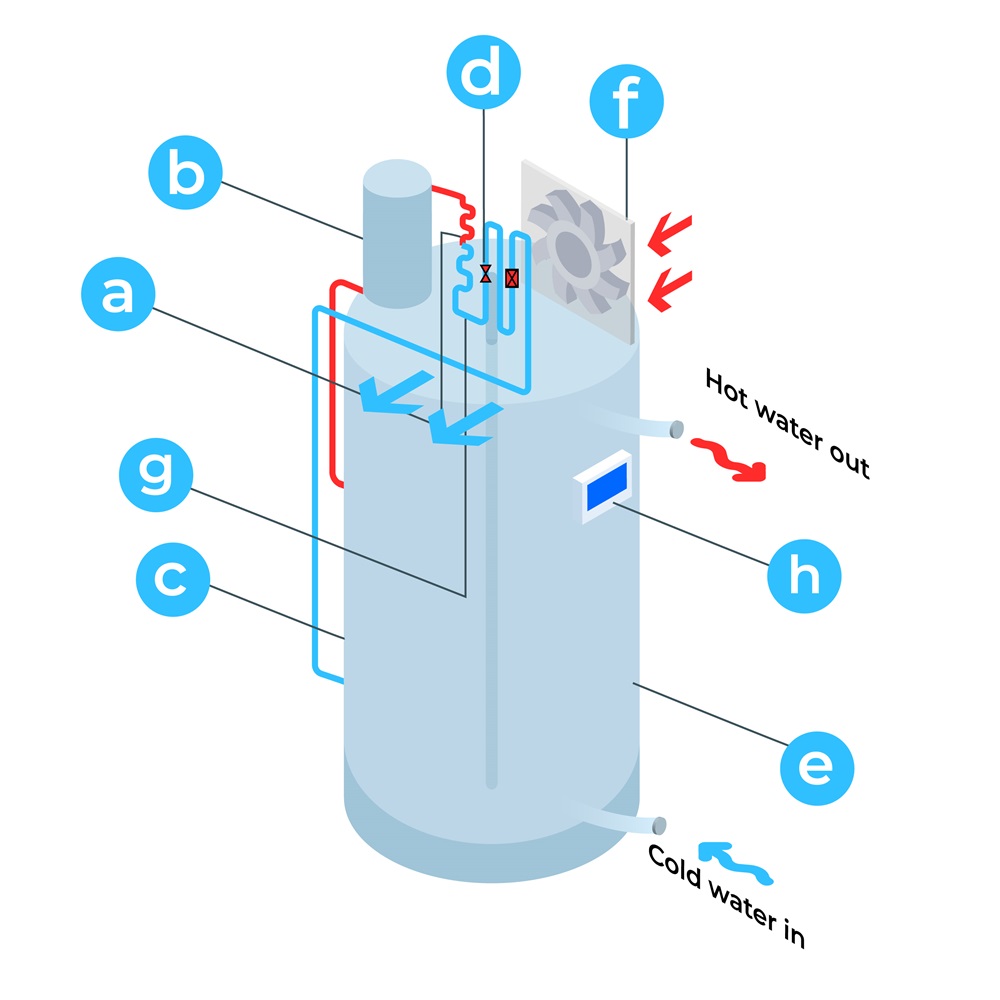
Heat Pump vs. Conventional Resistive Hot Water: How Do They Compare?
Heat Pumps are increasingly replacing conventional, resistive hot water systems because they are more energy efficient. But there are pros and cons when compared with resistive water heating:
| Heat Pump Hot Water | Resistive Hot Water | |
| Installed Cost | $3,000-$7,500 | $2,000-$3,000 |
| Efficiency | 300% (yearly average) | 98% |
| Power draw | 500-1,000W | 1,800-4,800W |
| Warranty | Compressor: 1-10 years Tank: 5-15 years |
Element: 1 year Tank: 7-12 years |
| Noise | 37-55 decibels | Silent |
| Heat rate | 40-80 litres per hour | 40-80 litres per hour |
Resistive hot water heaters are moderately smaller, cheaper, and silent in operation.
Heat pumps use about 3x less energy, averaged over a year, and are easier to run off solar power because they only pull 500-1,000W compared to 1,800-4,800W.
Heat Pump vs. Solar Thermal Hot Water: How Do They Compare?
Solar thermal hot water systems heat water directly using the sun’s heat. If there’s enough sun, no electricity or gas is required.
Solar thermal systems take cold water in, heat it with solar energy, and send piping hot water out. They cost from $4,000 for a ‘flat-plate’ system to $8,000 for better insulated ‘evacuated-tube’ systems suitable for cooler areas.
Here’s how they compare with a heat pump hot water system.
| Heat Pump Hot Water | Solar Thermal | |
|---|---|---|
| Installed Cost | $3,000-$7,500 | $4,000-$8,500 |
| Overall efficiency | Higher | Lower |
| Roof Space | Less space is required to generate solar electricity to heat water | More space is required for solar thermal collectors to heat water |
| Running Costs | Lower with rooftop solar | Under favourable conditions, lower than a heat pump without rooftop solar |
| Power draw | 500-1,000W | 1,800-4,800W when boosting |
| Warranty | Compressor: 1-10 years Tank: 5-15 years |
Element: 1 year Tank: 7-12 years |
| Noise | 37-55 decibels | Silent |
| Heat rate | 40-80 litres per hour | 40-80 litres per hour |
Heat pump hot water systems and electrically boosted solar thermal hot water systems use roughly the same amount of electricity. Solar thermal uses considerably more electricity (or gas) in cool and cloudy climates and less in warm sunny ones.
With rooftop solar, a heat pump hot water system will generally have lower running costs because it will mostly operate off solar electricity, while a solar thermal system will typically boost with electricity (or gas) when solar output is low. This results in more of its electricity consumption coming from the grid.
Heat Pump Water Heater Installation
Your HWHP must be installed to Australian Standards regarding the plumbing and electrics, the main ones being:
- AS/NZS 3500.4:2025 Plumbing and drainage, part 4: Heated water services
- S/NZS 3500.1 Plumbing and drainage, Part 1: Water services
- AS 3498:2020 Safety and public health requirements for plumbing products — Water heaters and hot-water storage tanks
- AS/NZS 3000:2018 Australian Wiring Rules
They must also be installed according to the manufacturer’s instructions.
Here’s an overview of some requirements. I discuss even more requirements and common mistakes in my dedicated hot water heat pump installation guide.
Temperature Control
According to Australian standards, hot water has to be heated to 60°C or higher to prevent Legionnaires’ disease, but it has to come out of the taps at 50°C or less to prevent scalding.
So, the simplest way to protect yourself is to make sure your hot water system operates long enough to reach that temperature every day, even if it starts with a tank full of cold water. This is usually 3+ hours, but for systems with a low tank recovery speed, it may take longer.
Tip: A comfortable water temperature for a hot water tap is 37°C to 42°C.
Other ways to control Legionnaires (AS 3498:2020 Section 7.2)
- 45% of the tank heated to 60°C daily, or
- 90% of the tank to 60°C once a week for 32 minutes, or
- the water being delivered hits 70°C for 1 second within the 7 days prior to delivery
Nerd Fact: If the water is stored at 60ºC and delivered at 50ºC or less, how does that work? A thermostatic mixing valve (TMV) in the context of a water heater is a device that blends hot water from the heater with cold water to ensure a consistent and safe output temperature. The primary purpose of a TMV is to prevent scalding by maintaining the water temperature at a safe level, typically between 38°C and 50°C, regardless of fluctuations in the hot or cold water supply.
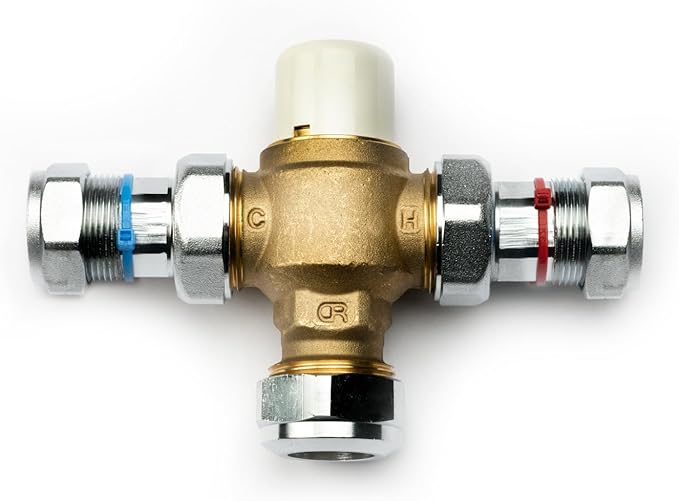
Image credit: Salamander Pumps
Plumbing Considerations
Below is a list of plumbing requirements for heat pump hot water installation. If you have a good installer, they’ll make sure to carry out every step correctly. If you have an excellent installer, they will go above and beyond to make sure the installation is problem-free and long-lasting. I’ve bolded commonly missed requirements that are easy for the layperson to spot.
- Use copper or stainless steel pipes within 1m of the heater outlet
- Support any valves to prevent movement during operation
- For smaller copper pipes, provide support every 50 cm
- Avoid wrinkles or flats on pipe bends and soldered joints on new connections
- Install thermostatic mixing valves (TMVs) to blend hot and cold water for safe output temperatures
- Properly support mixing valves independent of piping
- Provide proper base support for the unit
- Ensure correct installation of cold water inlet, hot water outlet, heat pump inlet and outlet (for split units)
- Ensure the drain runs into stormwater (not onto the floor)
- Insulate hot water pipes with UV-stabilised material, including elbows, valves and the first 300mm of drain
- Allow for proper clearances around the unit (typically 25cm)
- Flush pipework before testing
- Protect pipes in areas with freezing temperatures

Pro-tip: One of the most obvious things to see on a HWHP installation is the pipe insulation, specifically gaps in it. To clear up any disagreements, here’s what the Australian Standard (AS/NZ 3500.4) says needs to be insulated:
8.21 Piping associated with storage water heaters
Piping shall be thermally insulated to achieve minimum R-value as given in Table 8.2.1 for the climate regions identified in Appendix K for Australia and Appendix I for New Zealand, as follows:
(a) All pipework associated with storage water heaters shall be insulated for at least the first 500 mm, or where an external heat trap is fitted, to a point 150 mm down the heat trap vertical leg closest to the water heater.
(b) The primary flow and return pipes, including valves, between an auxiliary heater and a storage water heater.
(c) All relief valves fitted directly to a storage water heater.
(d) All vent pipes up to 300 mm above the maximum operating level of the heated water system.
(e) On multiple installations, where the heated water manifold, including valves, extends to a point at least 500 mm past the heated water outlet branch from the last installation.
(f) On a solar water heater installation, the pipework between a solar pre-heater and an in-line supplementary water heater on both hot water inlet and outlet pipes from both heaters.
The insulation installed in accordance with the above shall be installed so as not to impede the operation of valves.
Here is an example of non-compliant insulation:
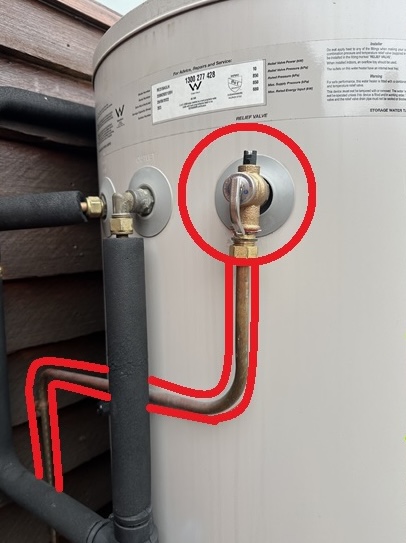
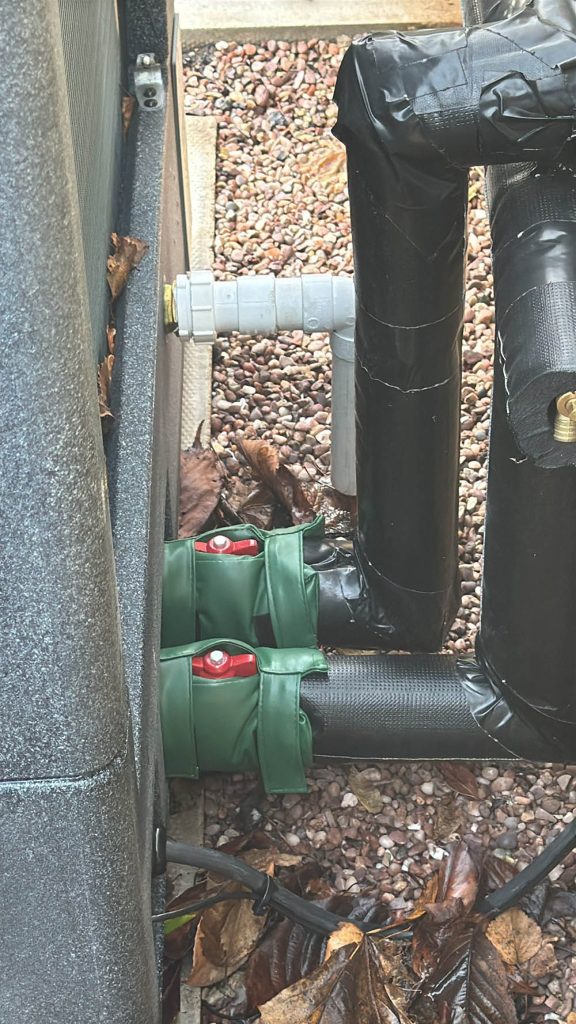
Heat Pump Hot Water and Water Quality
Sacrificial Anode
Your heat pump needs a sacrificial anode which will corrode instead of the storage tank. The anode material is chosen based on your local water chemistry.
In Australia, water quality varies depending on the region. Some areas have hard water, which has high levels of calcium and magnesium.
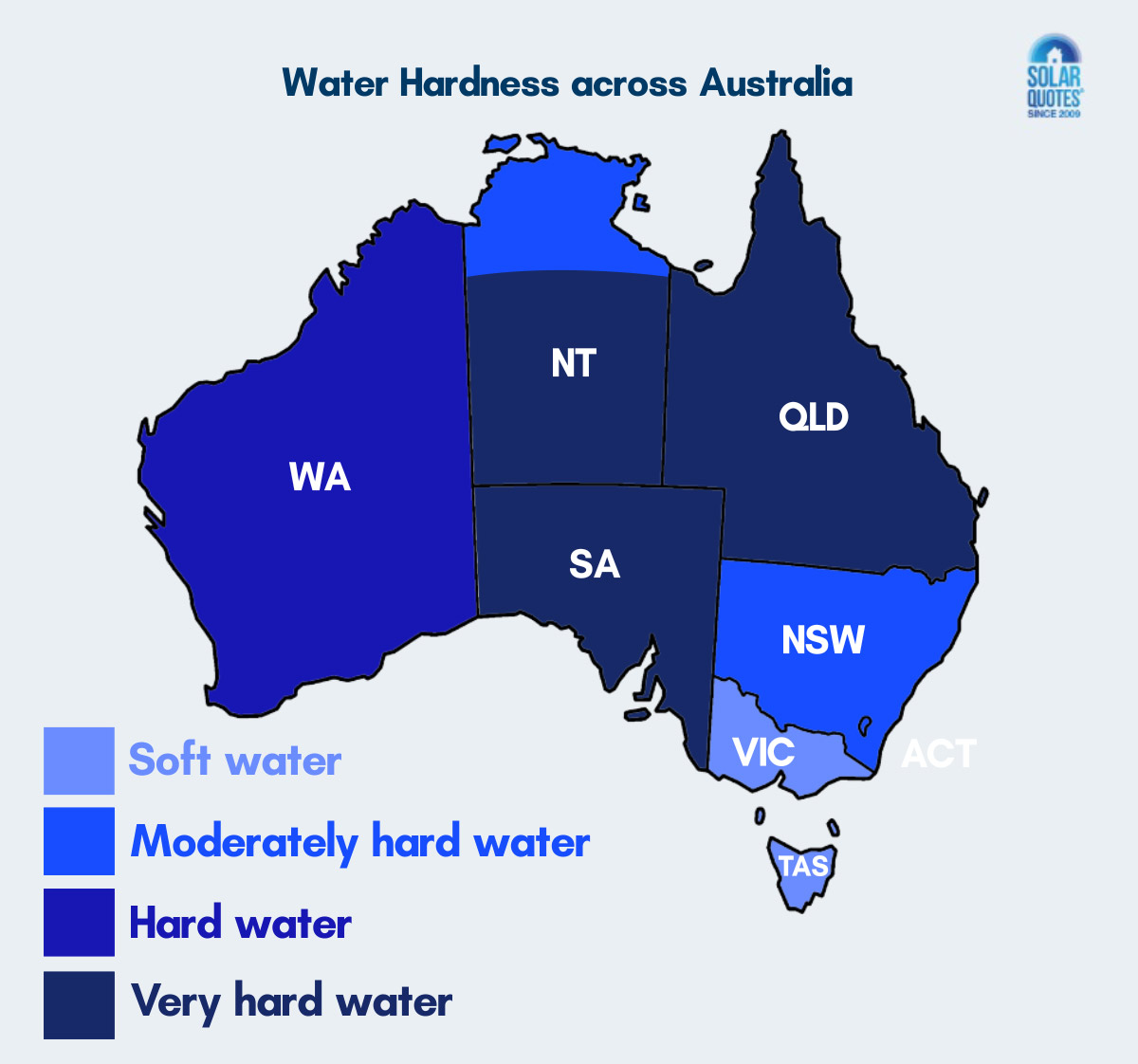
When hard water is heated, it tends to leave behind calcium carbonate deposits, leading to scaling. Scaling is more likely to occur in areas with hard water, and it can be a problem in heat pump water heating systems, among other appliances. What is Calcium Carbonate? Calcium carbonate is a white, chalky substance found in many rocks and is a common component in tap water. It’s harmless to drink, but when water containing high amounts of it is heated, it can form a solid layer inside pipes and equipment, causing blockages.
This buildup, known as scaling, can clog up pipes, valves, and especially the tubes in solar collectors.
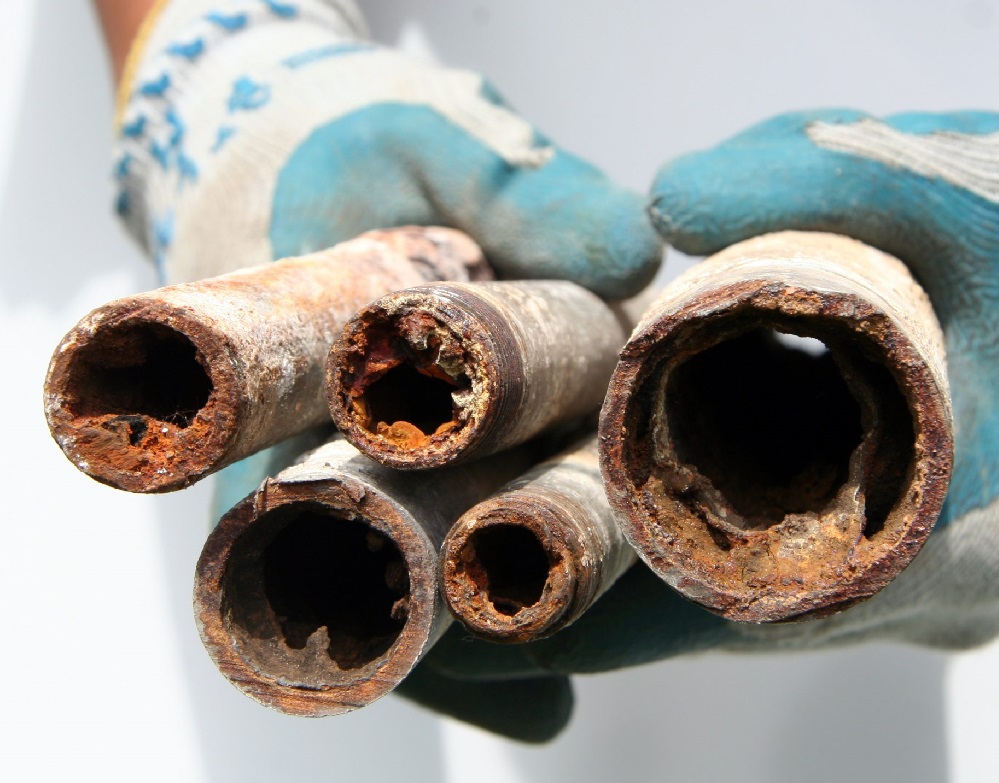
Image Credit: Water-IQ
Integrating Heat Pump Hot Water with Your Solar Panels
If you have solar panels, your solar electricity is the cheapest electricity available. So it makes sense to power your heat pump with solar as much as possible.
Heat pumps are great with solar power because:
- They typically draw less than 1000W – easy for most modern solar systems to power even in winter.
- They store energy. You can heat the water up in the day and use it after sunset.
To optimise your heat pump, you don’t need a fancy control system — just a simple timer.
Heat Pump Timer Control: Internal vs. External
All good heat pumps have a built-in timer. If you have one, use it — it won’t cut power mid-cycle (e.g., defrost/compressor), which helps reliability.
Set the timer for 11 a.m., and your hot water will be fully heated by early afternoon. Solar electricity powers it on all but the most overcast days.
If your model has no internal timer, a simple DIN-rail digital timer in the switchboard works. Set a single, generous daytime window so it won’t switch off mid-heat.
That’s all you have to do.
- In summer, one daytime window often suffices. In winter or big-family homes, add a second block or extend the window.
- Some models offer multiple/seasonal schedules via onboard controls or apps — use them.
- Make sure the total run hours meet the manufacturer’s minimum so you don’t run short.
One note of caution, though…
When I got my 323 litre heat pump, I put it on a timer, as above. But I kept running out of hot water.
My teenagers were having 30-minute showers at night, leaving no hot water for the morning.
So I disabled the timer, and just set it to reheat whenever required.
Luckily, I’ve got a home battery, which can easily supply the 2-3 kWh per night required to replenish the tank.
But that’s unusual. Most households won’t chew through all their hot water before morning showers. If they have teenagers, they practice better parenting than me.
My advice: when you first get your heat pump, set it to run 3-4 hours in the middle of the day, starting around 11 a.m.. If you find yourself running out of hot water, extend the time it runs for. If necessary, you can set it to run all the time, except for peak periods for those on time-of-use tariffs. If you can get cheap overnight electricity for under 25c per kWh, your top-up should be less than 50c per night. Still much cheaper than conventional electric hot water or gas. Alternatively, tell your teenagers to get out of the bloody shower.
Integrating Heat Pump Hot Water With Your Home Battery
Due to the federal battery rebate, more and more people own home batteries. This means making them play nicely with your heat pump is becoming more important.
If you have a home battery, you should still try to power your heat pump directly from your solar panels during the day. It’s always good to keep as much battery energy as possible available for powering the rest of your house through the night. The good news is – if you are hot water hogs, and need a nightly top-up, any good battery can handle the extra 1-2kWh easily.
Hot Water Heat Pump Reviews
Read real-life insights from Australian homeowners who have installed heat pumps in their homes. Share your own experience and help others make informed decisions.
FAQs
Are hot water heat pumps worth it?
A good hot water heat pump will reduce your water heating energy bill by about 70%, whether you currently heat with electricity or gas. If moving to an electric heat pump means you can remove your gas meter altogether, you’ll save even more because you’ll no longer pay the standing charge for connection to the gas mains (although you may have to pay for the removal of your gas meter).
A home with two or three children or one teenager might use 170 litres of hot water per day, which would consume around 10 kWh of electricity or 50 MJ of gas. If you pay an off-peak rate of 20c per kWh, that’s $2 per day. It’s a similar amount for gas. That’s about $700 per year. Expect your water heating energy bill to be about $500 lower with a hot water heat pump.
A good HWHP will cost about $3,000–$7,500 installed (not including any local heat pump rebates). So, in this case, your payback is between 6 and 15 years.
If your hot water consumption is only half this, you may consider the payback period too long to be worthwhile. If yours is one of the considerable number of households that consume over 200 litres of hot water per day, such as one with two teenagers taking 30 minute showers every night, the payback time can be much less.
Pro-tip: If you currently have instant gas hot water, you’ll use roughly 20% less gas than if you have a gas hot water with a storage tank. This is because you won’t have “standby losses” caused by the tank of hot water slowly cooling down. This will reduce the savings from switching to a heat pump, but it can still be worthwhile — especially if you quit gas entirely.
Heat pumps that reduce grid or gas energy consumption can provide a good return. But if you have a conventional resistive hot water system mostly powered by rooftop solar, the payback time may be too long to be worthwhile.
However, unless you have a huge solar system, a conventional electric hot water system on a timer that switches it on during the day isn’t likely to be mostly solar-powered. It can still consume plenty of grid electricity. This is because homes use the most hot water during winter and periods of cold cloudy weather when solar output is at its lowest. Heating elements in conventional hot water systems can also be large, with 3.6 kW and 4.8 kW being common sizes. This makes it hard for typical rooftop solar systems to provide most of their power. So switching to a heat pump can still provide a reasonable return to solar households, especially in colder parts of the country.
What are the disadvantages of a heat pump hot water system?
Compared to conventional, resistive hot water systems, heat pumps are more expensive, need more space, make a small amount of noise when heating, and have more moving parts.
The main disadvantage compared to instant gas hot water is once the hot water is gone, it can take up to an hour to get hot water again.
Will a heat pump work when it’s really cold outside?
Yes. Even when the air feels cold, it still contains heat energy unless it’s at absolute zero (−273.15°C). Heat pumps use refrigerants that boil and evaporate at very low temperatures, allowing them to absorb heat from cold air and transfer it to their hot water tanks.
In practical terms, a good hot water heat pump will happily work down to around −10°C, albeit at reduced efficiency (~150%), although ones made for European conditions can do better than this. Cheap units may switch to resistive heating in cold temperatures.
What is the COP of a hot water heat pump?
COP stands for Coefficient Of Performance — the ratio of heat output to energy input. At around 10°C ambient, many units have a COP around 3–4; at −5°C it can fall to 2; and around −10°C it may be 1.5 or lower.
The problem with comparing heat pumps by COP is manufacturers rarely clearly state how the figure was determined. A better real-world comparison is each how many STCs a heat pump receives in your climate zone, which we include in the comparison table.
Can I install a heat pump in my garage?
Probably not. You can install a heat pump hot water system in a garage, but it needs good ventilation and proper drainage. Without those, it won’t run efficiently and could cause water damage. In most cases, it’s better off outside. A good installer will be able to tell you if your garage setup will work.
Can I just use a controlled load instead of a timer?
If you don’t have solar, yes — look for retailers offering daytime controlled-load pricing. If you do have solar, a timer that targets your own PV will nearly aways provide a lower running cost.
Note: Some controlled-load setups can cut power mid-cycle on certain models, which can be bad for their long-term reliability. Check your model’s manual before relying on it.
Conclusion
Here’s a quick summary of the key points to remember when choosing a heat pump:
- Avoid cheap units: They’re often noisy, inefficient, and unreliable. Stick with trusted brands with great reviews, like iStore, Haier or Reclaim.
- Rebates are available: Government rebates (STCs) lower the upfront costs, and states and territories can offer additional rebates.
- Noise matters: Good heat pumps are quiet (37-50 decibels).
- Warranty: Aim for at least 5 years on the heat pump and 10 years on the tank.
- Installation: Make sure it’s done by a qualified installer following Australian Standards. Things you can check yourself are proper drainage and well-insulated pipes.
- Pair with solar: If you have solar panels, set a timer to heat water during peak solar production hours. If this leaves you with cold water in the morning, configure it to reheat overnight, too, ideally on a low-cost tariff.
If you are ready to buy a hot water heat pump, you can request up to 3 quotes from pre-vetted installers:
Get Up To 3 Quotes for a heat pump >>
Footnotes
- Because the anode is inserted from the top of the tank, it is approx. 4x longer than the side entry anode of an all-in-one
